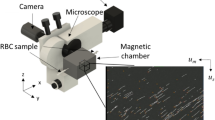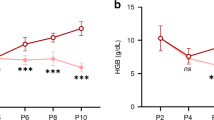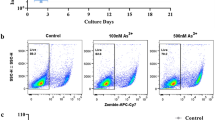Abstract
ADMINISTRATION of phenylhydrazine to birds and mammals causes severe haemolytic anaemia almost simultaneously accompanied by a compensatory erythropoietic response in the bone marrow. Although this procedure has often been used to obtain large samples of immature erythroid cells, no comparison has been made between the erythropoietic response stimulated by phenylhydrazine treatment and normal red blood cell (RBC) formation. Our intention was to make the comparison in the newt, Triturus viridescens, but although phenylhydrazine produced haemolysis and severe anaemia shortly after injection, there was no immediate erythropoietic response. Instead all erythrocytes were rapidly destroyed. The complete lack of erythrocytes persisted for approximately 2 weeks before any signs of RBC formation were observed. During this time, anaemic animals survived without great difficulty.
This is a preview of subscription content, access via your institution
Access options
Subscribe to this journal
Receive 51 print issues and online access
$199.00 per year
only $3.90 per issue
Buy this article
- Purchase on SpringerLink
- Instant access to full article PDF
Prices may be subject to local taxes which are calculated during checkout
Similar content being viewed by others
References
Ruud, J. T., Nature, 173, 848 (1954).
de Graaf, A. R., J. Exp. Biol., 34, 173 (1957).
Ewer, D. W., Nature, 183, 271 (1959).
Nicloux, M., CR Soc. Biol., 89, 1328 (1923).
Serfaty, A., Guetal, J., CR Soc. Biol., 137, 154 (1943).
Flores, G., and Frieden, E., Science, 159, 101 (1968).
Jordan, H. E., and Speidel, C., Amer. J. Anat., 46, 55 (1930).
Grasso, J. A., and Woodard, J. W., J. Cell Biol., 31, 279 (1966).
Rugh, R., Experimental Embryology, 49 (Burgess, Minneapolis, Minn., 1948).
Bloom, W., Anat. Rec., 69, 99 (1937).
Bloom, W., and Fawcett, D., A Textbook of Histology, ninth ed., 207 (Saunders, Philadelphia, Pa., 1968).
Czopèk, J., Copeia, No. 2, 91 (1959).
Foxon, G. E. H., in Physiology of the Amphibia (edit. by J. A. Moore), 151 (Academic Press, New York, 1964).
Krogh, A., Comparative Physiology of Respiratory Mechanisms (Univ. of Pennsylvania Press, 1959).
Prosser, C. L., and Brown, F. A., Comparative Animal Physiology, 153 (Saunders Philadelphia, 1961).
Author information
Authors and Affiliations
Rights and permissions
About this article
Cite this article
GRASSO, J., SHEPHARD, D. Experimental Production of Totally Anaemic Newts. Nature 218, 1274–1276 (1968). https://doi.org/10.1038/2181274a0
Received:
Revised:
Issue date:
DOI: https://doi.org/10.1038/2181274a0
This article is cited by
-
The newt as a model for studying dyserythropoiesis
Naturwissenschaften (1981)



